There
must be a dozen or more shareware and freeware apps themed closely
or loosely on Apple's old Note Pad desk accessory, a program that
dates back to System 6 days (and perhaps before). It was part of
the Mac OS when I came on board with System 6.0.1.
Steve Jobs apparently didn't like the Note Pad, hiding it by
default in OS 9 and then leaving it out of OS X
altogether - replaced by an enhanced Stickies application. Trouble
is, I - and apparently a lot of other Mac users - never really
liked Stickies, and the Note Pad void in OS X has created an
opportunity for third-party developers.
A couple of Note Pad replacements I like are the imaginatively
named Note
Pad, which among the various offerings most closely
approximates the original Classic app, and Note Pad Deluxe X,
which is really a mini-database program.
Sitting somewhere between those two variations on the Note Pad
theme is the subject of this review, Jotz 1.3.
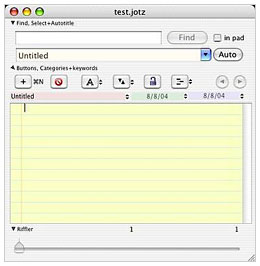
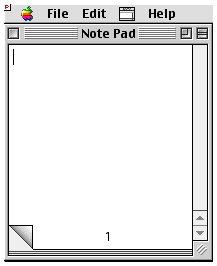
Default view for Jotz and Apple Note Pad
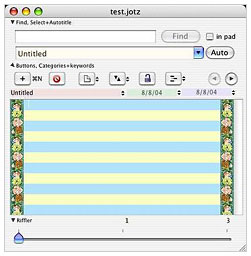 Jotz takes the notepad metaphor
whimsically literally, with its default lined yellow legal pad
interface motif. However, there are many available pad decor
options (including no decor), and you can substitute plain, ledger,
or quadrille formatting for the lines. To the right is "Roses" with
ledger formatting.
Jotz takes the notepad metaphor
whimsically literally, with its default lined yellow legal pad
interface motif. However, there are many available pad decor
options (including no decor), and you can substitute plain, ledger,
or quadrille formatting for the lines. To the right is "Roses" with
ledger formatting.
The program's files are kept in a folder called "Jotz Folder",
which is located at the root level of your Documents folder in your
Home folder. A Jotz Folder must remain in that location and have
that name for Jotz to find it, but you can replace it with an alias
to a Jotz folder somewhere else if you wish. The single location
makes several of Jotz's features possible, such as multi-Pad
searches and hierarchical Pad-note menus.
The Jotz folder contains your pads, and inside the pads are
notes. You can create new folders inside the Jotz folder to add a
hierarchical organization to your pads. Jotz will automatically
regenerate the affected menus. You can open a Finder window on the
Jotz folder by using the Open Jotz Folder command from Jotz's File
menu.
If you need to move Jotz to another computer that has never had
Jotz installed, just copy the Documents folder containing the Jotz
folder to the new computer, and all of your preferences (including
your registration serial number) will automatically follow - a
nice, convenient touch I wish other developers would emulate.
Jotz' basic document type is the Pad. Each Jotz Pad contains an
unlimited number of Notes. Each Note is a full Rich Text document
capable of supporting fonts, styles, colors, images, and
attachments. In Jotz, the Note corresponds to an individual sheet
of paper in a regular paper notepad - except that Jotz Notes are of
unlimited length and can do much more.
Each Jotz note is actually an RTFD file, so individual notes can
be dragged from inside the Pad and opened with any RTFD-capable
application, such as TextEdit.
A note can contain just about anything. You can drag text,
pictures, even applications and other kinds of files onto a note.
All items that aren't text are stored as separate files inside the
Note's file package.
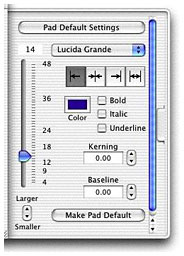 Jotz has three classes of Cocoa drawers:
Jotz has three classes of Cocoa drawers:
Pad-related drawers: Drawer deals with pad data in some
manner
Examples: Shuffle Drawer, Text Drawer
Application-wide drawers: This drawer deals with a
single, application-wide data source, regardless of what pad it is
opened in.
 Examples: To Do Drawer, Reference Drawer
Examples: To Do Drawer, Reference Drawer
Utility Drawers: Drawer is a tool for manipulating data,
and each instance deals with a data source unique to it, but
unrelated to the parent Pad.
The tab on the right-hand edge of the drawer is the drawer-close
tab.
Jotz tries to retain as many of the benefits of a paper notepad
as possible. As notepads rarely stick Save dialogs in your face,
Jotz doesn't either. Each Jotz Pad periodically checks to see if it
has been changed recently, and does a background Save operation if
it has. You can also save manually if you wish.
Jotz' auto-title system creates a list of all of the words in
the note, removes the most common words (in multiple languages),
and then strings together what it sees as the most significant
words based on statistical language theory. The resulting title is
usually representative of the note contents, although it is
generally not polished prose. AutoTitle is not intended as a
substitute for your own title, but as a convenient shortcut that is
vastly superior to a collection of Untitled notes.
AutoHide causes Jotz to Hide itself when it hasn't been used for
a while. This can be disabled in the Jotz Preferences.
The MultiButton (short for "Multifunction Button") is a
user-configurable button control. There are two MultiButtons on the
Pad.
 If you click-and-hold on a MultiButton, a popup menu
appears that looks like this:
If you click-and-hold on a MultiButton, a popup menu
appears that looks like this:
The top items in the menu (with icons) can be programmed into
the MultiButton by simply selecting them from the popup menu. The
MultiButton icon will change to match the icon on the menu item,
and the item feature will be activated. The MultiButton will
remember its setting for its pad. Once set, a normal button click
on the MultiButton will toggle the MultiButton's current feature.
If you select one of the convenience items at the bottom of the
MultiButton popup menu, that feature is activated without changing
the MultiButton setting.
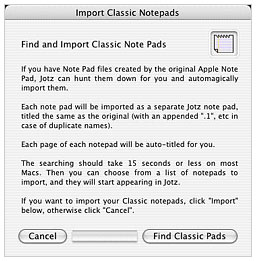 Jotz can also find and import Classic Note Pad
notepads, stickies files, as well as importing RTF and RTFD files.
To import your old Classic Mac OS Note Pads, select Find and Import
Classic Note Pads from the File menu, and follow the onscreen
instructions.
Jotz can also find and import Classic Note Pad
notepads, stickies files, as well as importing RTF and RTFD files.
To import your old Classic Mac OS Note Pads, select Find and Import
Classic Note Pads from the File menu, and follow the onscreen
instructions.
Jotz will find any Classic notepads on your mounted volumes and
let you select which ones to import as new Jotz pads.
To import a plain text, RTF, or RTFD file as a Jotz note, open
the pad that you want to add the note to, and then select Import...
from the Pad menu. Jotz will create a new note and set its contents
to the contents of the file.
Jotz has numerous methods of jumping to a particular note:
- You can open the Shuffle Drawer of a Pad and click on the Note
title
- You can use the Select Pad or New Note In Pad items of the Pad
menu.
- You can use the similar menus available from Jotz's Dock menu
when Jotz is running
- You can use the contextual menu available from the Iconize
window when Jotz is Iconized.
- You can use the Note Selection Combo Box at in the Full
Featured Pad mode: (click on the blue arrow thingie)
- You can click-and-hold on the Note Title text area just above
the pad contents to get a popup of all the Notes in the Pad.
- You can use the Browser Style Search to find the note, and then
double-click on the results to be taken there.
- You can just use the Riffler or the Next-Previous buttons to
just browse around.
I've found plenty to like in Jotz, which abounds with thoughtful
and innovative touches, like the fact that Jotz documents can be
opened with any application that supports RTFD files. I hate having
my data locked into proprietary file formats.
The Jotz interface is attractive, flexible, and functional.
Having a search field right in the Pad window is convenient, and
the multiple drawers toggled by the multibutton are great. Jotz
also supports OS X Services.
There are also a few things I don't like. Some standard Mac OS
keyboard shortcuts, such as F3 for Copy and F4 for Paste, are not
supported, which I miss, and drag & drop is not always as quick
as it might be - in or out, although this has improved
substantially in recent Jotz versions.
I find that Jotz interface response in general tends to be
draggy and hesitant (this is on a 700 MHz G3 iBook), and Browser
toggling from Web URLs in Jotz pads is way too sensitive.
Also, there should be an undo function (preferably multiple undos).
I lost a half hour's work on one occasion due to a keystroke
error.
And then there are odd glitches like Jotz leaving this artifact
on my desktop for several days.

However, those are relatively minor niggles. In general, this is
a nice little note pad application and a very decent value at
$17.95
Jotz Features:
- Rigorous adherence to the Classic notepad metaphor. This is a
notepad, not a database or a PIM.
- Near-zero learning curve. Tested on both "techie" and
nontechnical users. (true for basic functions, although some of the
advanced features require scaling a learning curve)
- Commonly used functions available on pad window. (New Note,
Select Note, Shuffle Notes, Find, etc.)
- Notes are individually dated with creation and modification
dates.
- Automatic Find/Import of Classic Note Pads.
- Autosave: Changes made to a note are intelligently saved in the
background within seconds.
- Background note-loading: even very large notepads immediately
available.
- One-button automatic polylingual significance-theory note
auto-titling (currently supports English, German and most Romance
languages).
- User-configurable auto-hide: minimizes desktop clutter.
- "Shuffle Drawer" for easy note reorganization: notes can be
dragged around inside the pad, or between pads.
- Multilevel, multi-pad search (Search in: current note; current
pad; all open pads; all pads in Jotz folder).
- Simple and Full interface styles. See for images
- 100% "live" (non-modal) preferences.
- Auto-closing drawer-based alerts instead of flow-disrupting
alert windows or sheets.
- Full Cocoa application, not Carbonized Classic app.
- Standard file format (RTFD) for robust data availability. You
can read your notes without Jotz, if need-be.
- Unlimited notes
- Unlimited Note Pads
- Unlimited note length
- Notes can be text, graphics, web pages, whatever
- Drag and drop import of numerous file types
- Drag and drop export to RTFD (TextEdit) files
- Drag and drop Notes between Pads
- Finds and imports Classic Note Pad files
- To Do Drawer
- Reference Drawer
- Sophisticated printing control with WYSIWYG preview
- Each pad has Full-contents "live" search
- Multi-Pad "Browser Style" search
- Sorting on multiple attributes
- User configurable Pad background decor
- Multiple Pad window designs
- Alias support for desktop/laptop sharing
- Encrypt Notes with Blowfish
- Automatic note title generation
- Automatic note time/date stamping
- Open file format - notes can be read by TextEdit
- Robust, auto "safe save" every few seconds
- Extensive Undo support
- User configurable Pad layout
- Built-in suggestion box: encourages feedback from users.
- System Services
- Sensible, easy to live-with, real-world license:
Upcoming Jotz Features
- Timed reminders
- One-window, all-pads "iJotz" interface option
- Journal window
- Transparent Auto-encrypt/decrypt option
- Network note sharing/collaboration
New in version 3.1.12:
- Jotz now validates the printer information object returned by
the operating system, as it appears that it is occasionally
possible for that object to be incorrectly configured, which could
cause Jotz to fail to display Pads correctly.
- Jotz is now more robust with respect to corrupted Pads.
System requirements: Mac OS X 10.2 or higher.



 Jotz takes the notepad metaphor
whimsically literally, with its default lined yellow legal pad
interface motif. However, there are many available pad decor
options (including no decor), and you can substitute plain, ledger,
or quadrille formatting for the lines. To the right is "Roses" with
ledger formatting.
Jotz takes the notepad metaphor
whimsically literally, with its default lined yellow legal pad
interface motif. However, there are many available pad decor
options (including no decor), and you can substitute plain, ledger,
or quadrille formatting for the lines. To the right is "Roses" with
ledger formatting. Jotz has three classes of Cocoa drawers:
Jotz has three classes of Cocoa drawers: Examples: To Do Drawer, Reference Drawer
Examples: To Do Drawer, Reference Drawer If you click-and-hold on a MultiButton, a popup menu
appears that looks like this:
If you click-and-hold on a MultiButton, a popup menu
appears that looks like this: Jotz can also find and import Classic Note Pad
notepads, stickies files, as well as importing RTF and RTFD files.
To import your old Classic Mac OS Note Pads, select Find and Import
Classic Note Pads from the File menu, and follow the onscreen
instructions.
Jotz can also find and import Classic Note Pad
notepads, stickies files, as well as importing RTF and RTFD files.
To import your old Classic Mac OS Note Pads, select Find and Import
Classic Note Pads from the File menu, and follow the onscreen
instructions.
